Pinecrest football
In sickness or in health, let's keep Patriot football
Moore County Independent, September 2006
SPECIAL TO THE INDEPENDENT
The idea of scrapping a high-school football team is about the worst news its alumni can hear. And I'm happy Pinecrest will keep its season going, good or bad. The school made the right decision in not abolishing the team, even though low numbers and injured players could put the Patriots out of commission this year anyway. Besides, even if you're not a big football fan, you should bear in mind that public schools and colleges throughout the United States depend on the success of their football programs to generate revenue, not only for the athletic departments, but for the entire educational institutions.
Pinecrest athletic director John Buchholz (whom I've known since the last few years of old East Southern Pines) told the media the team had more than 90 players, with 44 freshmen in the program. There were six seniors and 14 juniors, a regional publication reported.
I'm afraid you can't have much of a football season with numbers like that. It would be tempting to call it quits. If you don't have enough players to field a team, then you don't have any other choice except to break up its program for the year. But we always have to think of the kids on the team. I mean, football is their lives, and I think the really dedicated players would rather go 0-10 than hang up their uniforms after just three bad games.
Pinecrest does have its moments, however. In 1987, the Patriots finished in the second round of the state playoffs. They edged out E.E. Smith 8-7 in the first round, then fell to the eventual state 4-A champions in Garner in the second round. That was the year Garner's roster included former Richmond Senior state title coach Hal Stewart and N.C. State star-to-be Anthony Barbour.
Pinecrest even beat Richmond one year. By a score of 26-25, I believe it was, in 1992.
Those who remember that game know there were, unfortunately, extenuating circumstances.
That extenuating circumstance being that Richmond's starting quarterback had gotten busted for a huge drug offense -- about $10,000 worth of cocaine. He didn't play in the game that night, and the whole Raider team was so demoralized. The coaches walked around with ashen looks, and none of them talked to me. The Richmond County Daily Journal ran the story of the young man's arrest on the front page.
But as far as the Patriot faithful were concerned, a win's a win.
That win also happened to be the Raiders' Homecoming football game. How many times does that happen at Richmond Senior High School.
It's not as if the school doesn't have that much athletic talent. Far from it. Patriot football has included some outstanding individuals who go on to play Division I football and even make the pros. My own class (1971) included three gridders who played in the ACC. Charles Waddell (that's right, the One and Only for those in the Pinecrest community who remember him) played three sports at the University of North Carolina and spent a season in the NFL. Joe Robinson played defensive back at N.C. State and Ernest Clark went to Duke. Dexter Pride, who graduated a year later, played in the NFL, too. And one year, six Pinecrest alumni received football scholarships to the prestigious Johnson C. Smith team.
And there are scads of other success stories about former Pinecrest football players.
Ironically, Pinecrest has a quality athletic program, winning conference championships in about all its other sports and state championships in quite a few, including baseball, basketball, volleyball, golf, tennis and track. But Pinecrest has always had a jinx when it comes to its football team. The Patriots have not made the state football playoffs since 1987, and then one or two times before that.
So you can't blame the players, and you can't blame any one or two coaches. I think the numbers are to blame; so is the inability to retain a lot of players throughout the program. And the number of fans and parents who just shrug their shoulders and quit going to the games as soon as the Patriots' chances of landing a state playoff berth go south.
I have lost track of how many coaches have come and gone since the school opened in the fall of 1969. They last five or six years, perhaps, and then they move on, either quitting on their own or getting sacked. No, you can't blame any coach for the kind of ills afflicting Patriot Football. When you get rid of one, you could bring in another with an impressive win-loss record, and then that coach could end up winning six or seven games at the very best.
I covered sports full-time for almost 16 years, first for the old Citizen News-Record and later for the Enquirer-Journal of Monroe and the Richmond County Daily Journal. I don't live in the county and I don't see that many of my old classmates. But in all that time, whenever I happened to cover a Pinecrest football game, it pretty much amounts of a class reunion. Every time I go there I can count on seeing at least one person I knew at Pinecrest. I've met old schoolmates who have become teachers and coaches; who have children on the team; or just be eternally loyal Patriot supporters, with blood running dark green and gold until their dying days. They know their alma mater has never had a powerhouse team to match Richmond Senior's or Scotland County's or Douglas Byrd's. But they come anyway and cheer for their favorite football team on God's Green Earth.
Go, Patriots!
40 years in the Sandhills
40 years of life in the Sandhills
The best of all possible small-town worlds
Unpublished, written Sepember 2006
SPECIAL TO THE INDEPENDENT
Can you imagine living someplace where you can walk to school, work, church, the grocery store, the doctor's office and even the movies?
When I was 14, I moved to a place like that.
It was called Southern Pines.
My family moved there from Winston-Salem, when my father took a job with one of the newspapers in Moore County. I had spent the whole summer reading my parents' hardbound issues of American Heritage, and the first time I set foot in downtown Southern Pines, I felt as if I had gone back in time -- to the 1920s.
Last month I celebrated a unique anniversary, folks. Forty years ago in August, I came to Moore County.
I'm sure about half of our readers were either not born before August 1966, or they weren't living here. That's father time for you. Still, it's too bad so many people will never know exactly what it was like back then.
My family lived on Ashe Street, a block up from downtown Southern Pines. The fire station was around the corner from us. We lived:
* a block from a Colonial grocery store (anybody remember that chain, with its Gold Bond stamps?) and St. Anthony of Padua's Catholic Church (if we were Catholics, we'd have really loved that!)
* a block and a trip across the railroad tracks from the Sunrise Theater (it closed down during the 1980s, but now it's become a popular entertainment venue)
* about three blocks from The Pilot, where my father worked for the first two years we lived in Moore County. We also lived about that far from the Chamber of Commerce, where my mother later went to work
* about four blocks from our doctor's office. The late Roy McMillan had his office next to what is now the municipal building.
* four to five blocks from East Southern Pines School, which comprised all 12 grades until the fall of 1969, when all the schools in the county became consolidated and
* a bicycle ride from both a quality men's clothing store and our family dentist's office (Dr. Robert Bruce Warlick, now retired).
That's not all. Even though none of us played golf, my parents loved this place. They had gotten tired of living in a city the size of Winston-Salem, and the quiet, rural yet highly classy towns of Pinehurst and Southern Pines tugged at their heartstrings.
I have a confession to make: When they made the announcement that we were leaving our home of nearly the past five years, they had a very upset young son to deal with.
I was about to start eighth grade at Dalton Junior High School. The year before that, I had to undergo the stress of a new school, when my class went from sixth grade to junior high school. We had lived in two other places in Winston-Salem several years back, after moving from Asheville. I was getting awfully sick of moving from one home to another and one school to another, and now it was going to happen all over again.
As seventh-graders, my classmates and I got picked on a lot by the eighth- and ninth-graders, but that summer had a lot of promises to it. I was taking judo lessons at the YMCA as well as a clinic where one of Dad's friends was the instructor. I was looking forward to taking classes such as creative writing and shop as eighth grade drew near. Not to mention the fact that now that I was a big eighth-grader, nobody was going to pick on me. The incoming seventh-graders were going to have to put up with the same thing we did, and by the grace of God, none of us were in those particular shoes anymore.
I'm afraid I was a bit too young to appreciate the same things my mom and dad saw in Southern Pines in the fall of 1966. On the other hand, I had good reason not to like the move. For one thing, the Winston-Salem city schools were a lot more advanced than the schools in Moore County, which were under the control of the towns until the fall of 1969, when the schools were consolidated and Pinecrest opened.
The southern area of Moore County had five different high schools, including two in Southern Pines. We had East Southern Pines, and West Southern Pines in the predominantly black section of town. The towns of Aberdeen, Pinehurst and West End all had their own schools. And the fights that took place after the football games between East Southern Pines and Aberdeen were legendary. If you can find one of the baby boomers, or anybody older, who lived in this county back then, please get him or her to tell you what life was like as a teenager in this county.
At first I hated Southern Pines because, while I liked the countryside and the quiet, Winston-Salem had a lot of places Southern Pines did not. That included a Y, a beautiful, new and very large public swimming pool and a wider selection of courses in the junior high and high schools at East Southern Pines. In seventh and eighth grades, East Southern Pines did not have French, Spanish or Latin, and no advanced math or accelerated English courses. Each of these grades had four teachers, teaching only four different subjects and one of them teaching phys ed: English, math, science and social studies. Each class consisted of four groups, rotating among the four classrooms.
When I started eighth grade at East Southern Pines Junior High School, I felt as if some vengeful principal had bumped me back into the sixth grade.
Oh, man, I hated it down here.
But then I started making friends, and my class consisted of at least five other kids in the same boat I was, moving from larger towns early in the school year. In fact, the first two people who made friends with me were transplanted Yankees: Tommy Chaltas, a native New Yorker, and Jonathan Lyerly, who came from Indiana, I believe.
And none of the kids I knew really liked living in Moore County. We had that much in common. Throughout our teen years, many of us sat around the town park, by the tennis courts -- this was the town park on Ashe Street and New York Avenue, folks, not the one adjacent to the U.S. 1 bypass -- and talk about how one day we would all go to New York and make it big and never come back to this little hick burg again. As far as we were concerned, Southern Pines and Pinehurst could draw all the rich Yankee golfers they wanted and still be redneck towns.
But that was when we were young and full of spit and vinegar. Many of us did leave Moore County after we graduated from high school, either going to college or joining the military. But so many of those bored-stiff teens have come back to Moore County, to do their lives' work and raise their children in the very place they called hicksville. And our class reunions draw a lot of local alumni who live in other towns and states.
One of my oldest friends came back after making it big in the big city, like so many of us Moore countians used to dream about. Bobby Levy skipped a grade and became an attorney. He moved to Los Angeles, where he practiced law for 27 years.
But Bobby could not get Southern Pines out of his blood. He planned to come back for a long time, opening a toy store here, and entrusting it to the care of two of his parents' friends.
Ten years later, he, his wife and the youngest of their three daughters made the move back east. Bobby phased himself out of the West coast law field and took over the management of The Little Toy Shop. This was last year.
One of his biggest reasons: "I wanted my daughter to go to the same school I went to, and to enjoy the same atmosphere I did when I was her age."
In seventh grade, I took half a semester of French and typing. Eighth grade had the courses I mentioned, and students who were good enough in math could take algebra in eighth grade.
I don't live too far from Moore County: A half-hour drive away, in Hamlet. I have not resided in Moore County since late 1987, but I have, over the years, grown to love the so-called hick burg where I grew up and spent a great deal of my adult life. Recently I even enjoyed a homecoming, when I took some courses at Sandhills Community College. I received an Associate in Arts degree there in 1975, and last year I took a course under an instructor who was there back then. She was in her 20s when she joined the faculty, and I never met her in person until just last year. When I talked to her recently, she remembered many of my old classmates.
I still keep in touch with one of my former teachers, from the first year at Pinecrest. She left that school after a year, but came back in the 1980s, remarried and moved to Pinehurst. She continues to be one of my biggest supporters and one of my oldest friends. She and so many other people I have known and loved in the four decades I have spent in the Sandhills are the main reason I'd rather stay here than live any other place in the world.
I still bump into another old classmate every couple of months or so: K.C. Cathcart. He came here from Greensboro the month after I did, and he and Jonathan Lyerly were pretty good friends, too.
Then this summer, something amazing happened: Jonathan came back to town.
He lives in California. He came here to visit his mother and three siblings. He also plays in a bluegrass band and they did a gig in town. Unfortunately, I could not get away to see them the night they played. That was the first time I'd seen Jonathan since 1974.
Hamlet's a nice little place with a lower cost of living than Moore County, but I'll call Southern Pines home until the day I die.
I could be a filthy rich millionaire, living in a villa in Europe, but if I couldn't get back to Southern Pines every once in awhile I'd be totally miserable.
The Sandhills is where my friends are. It's where my home is.
As the Tremeloes sang in the British invasion hit "Tobacco Road," "'cause it's home."
That was a Top-40 tune when I came to Southern Pines. I'm glad I eventually took those lyrics to heart.
I wouldn't live anywhere outside of this area for anything on God's Green Earth.
True Blue. As blue as East Southern Pines's Blue Knight mascot.
Low-cost spay/neuter clinic
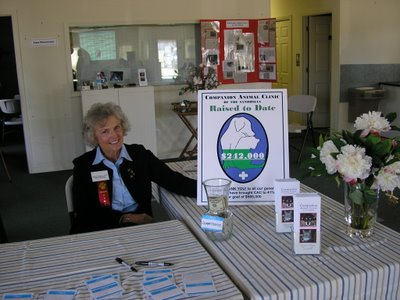
Cynthia Williams of the Companion Animal Clinic of the Sandhills sits beside a sign that shows how much the non-profit organization has raised for its low-cost spay/neuter facility.
Pet clinic hopes lower spay/neuter fees
will help curb overpopulation
Moore County Independent, Oct. 19, 2006
SPECIAL TO THE INDEPENDENT
VASS -- Dog and cat owners have heard this plea for years: Spay and neuter your companion animals, because each year the country has too many of them and not enough homes for them.
Many people would love do do that, but such procedures are luxuries they can't afford.
The Companion Animal Clinic of the Sandhills will soon be able to help those people, in nine counties of central North Carolina. The clinic has acquired a facility between Southern Pines and Vass, to spay and neuter dogs and cats at a reasonable cost. The CAC held an open house for the facility Sunday afternoon, to commemorate the event.
The clinics fees are expected to be $35 to neuter an adult tomcat, and $45 apiece to spay/neuter a dog of either sex and a female cat, Wilson says.
Thanks to a number of animal lovers with purses to match their enormous hearts, this place is news for low-income families and their four-legged friends, says Deborah Wilson, president of the CAC's board.
About 80 animals a day are euthanized in the nine counties served by the CAC. "For every one animal that's adopted, there are eight or nine that aren't," Wilson said. She added that North Carolina is one of the top three states to produce too many pets.
In 2005, county animal control received more than 3,000 animals, the clinic reported. About 65 to 70 percent of unwanted animals turned in to shelters have been euthanized, said Joe Currie, a retired veterinarian who serves on the CAC board.
Getting the CAC up and running is important because of the severity of the overpopulation problem in the Sandhills, Wilson said.
The clinic is expected to open in about the spring or summer of 2007, as long as funds come in as expected. An anonymous donor paid for the building, said board member Pat Smith.
The clinic will serve Moore County and eight other counties, Smith added: Chatham, Cumberland, Harnett, Hoke, Lee, Montgomery, Randolph and Richmond.
"We have met with the animal control officers (of all the counties)," Smith said.
"It's going to be the best thing that's happened to this county in terms of animal control. A lot of the surrounding counties are (delighted) about it," Wilson said.
Smith said the clinic hopes to bring a program to the schools to educate students about the importance of spay and neutering companion animals. She believes the surrounding counties, with more rural areas, will benefit especially from the clinic's low-cost spay/neuter program.
The CAC will not serve as an animal shelter but will be strictly for spay and neutering procedures for dogs and cats, Wilson said. The clinic needs to raise a total of $595,000 for the programs it has in the works. Already $242,000 has been raised, Wilson said. This does not include the money that went to the purchase of the clinic, Smith added.
"We will not open the clinic until we've raised at least half of the $595,000," Wilson said recently. "And we're almost there."
"We were working on this awhile," added Wilson, a history and geography instructor at Sandhills Community College.
A good chunk of the funds raised came from the clinic's "De-Sex in the City" dinner dance and auction, held Oct. 7 at The Fair Barn in Pinehurst, Wilson said.
"We won't have any services until the clinic's ready," Wilson went on. "We're not a housing facility."
Wilson said when the clinic opens, two veterinarians and a number of veterinary technicians will be hired to perform the procedures. The surgery "will be done light," Wilson said. "We're not going to pass the cost on to the public."
In the meantime, the money raised is going towards the renovation of the building, located just north of Dunrovin Country Store, on U.S. 1 North.
Wilson hopes to obtain a grant from the state, and will also continue to depend on private donations.
The clinic has been a hit with the public as well as local veterinarians, Wilson said.
"The community support has been incredible," she said. "It's just heart-arming how many people were there (at the dance). I think the community is ready for this."
Local veterinarians are very active in this program, Wilson said. She says they make no money off the vouchers they provide for indigent cat and dog owners. "This program will take the burden off them."
One of the goals "is to make it so the CAC only has to put on one good-sized fund-raiser a year," Wilson said.
This program began two years ago, and its 501C-3 status was granted by the state of North Carolina early this year, Wilson said. This is a status granted to non-profit organizations.
The clinic is not setting sail in uncharted waters, Wilson said. It is modeling its system on a "tried and true" program, the Humane Alliance of Asheville. The Moore County clinic is working with both the Humane Alliance and the North Carolina State veterinary school.
The Humane Alliance serves 23 counties in western North Carolina, with its own low-cost spay/neuter program. A drastic reduction in the euthanasia rates has been reported in those counties.
"We didn't invent any of this," Wilson said. "It's proven. We know it works. The Asheville Humane Alliance has reduced the euthanasia rates by over 65 percent."
Sunday's open house featured a floor plan, with the various areas marked off: The surgery operating room, the garden, an enclosed outside kennel, a surgery prep room, recovery rooms for felines and canines, an employee lounge and an examination room. Donors can have the rooms named after them for various amounts contributed.
Wilson said the clinic doesn't expect to make much of a difference in the overpopulation rate at first, but "I think by the third or fourth year we're going to see a dent in it, a sizable reduction in the euthanasia rate."
"Dogs and cats can enrich your life," Wilson said. "It's not fair to not own an animal just because you can't afford one. That's not our philosophy. We're going to make it easy."
Currie, Smith, Wilson, Barbara Mudge, Neal Jarest, Marie Schwindl, equine veterinarian Tom Daniel and Cynthia Williams are on the board.
For more information on the Companion Animal Clinic, visit its Web site at www.companionanimalclinic.org; write Companion Animal Clinic, P.O. Box 148, Southern Pines, NC 28388; or call Wilson at 692-9650.
Animal shelter employees take no pleasure in performing one of their many tasks, that of euthanizing healthy, friendly animals, Wilson said. If the clinic can drastically chop the rate at which unwanted cats and dogs end up being put to sleep, it will help abolish the negative image of animal shelters as execution chambers, she says.
"We want people to think of shelters as places you go to adopt animals, not where you take them to be put to sleep."
Moore County Choral Society
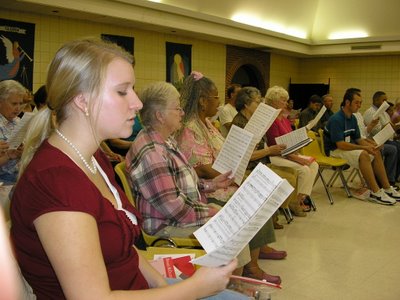
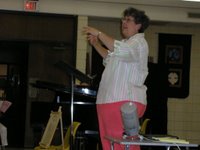
Moore County Choral Society Conductor Anne Dorsey
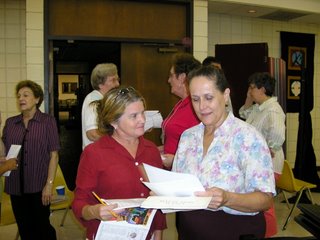
Cynthia Williams Leach, left, talks with piano accompanist MariJo Brown.
Wine gala benefits time-honored choral group
Moore County Independent, Oct. 19, 2006
SPECIAL TO THE INDEPENDENT
Music lovers had themselves wined and dined for a noble cause this week. The Moore County Choral Society was scheduled to hold a wine gala Tuesday evening at the Fresh Market in Southern Pines, to raise funds for this group of about 104 performers.
"Fresh Market's been good enough to allow us to do that," said.Anne Dorsey, conductor of the Choral Society.
Approximately 40 to 50 wines were available for tasting and for sale, as the Moore County Choral Society entered its 32nd year. It is a local, non-profit organization which performs countywide. It also has concert scheduled this spring in Fayetteville and at Pinecrest High School, in collaboration with the Fayetteville Symphony Orchestra.
The wine gala, the Choral Society's first ever, took place after deadline. Dorsey, a music instructor at Southern Middle School who has served as the conductor for the past five years, felt the event could not come at a better time. The annual Holiday Concert is about a month and a half away. Specifically, it is scheduled for Saturday and Sunday, Dec. 2-3, at Sandhills Community College, with performances at 8 and 4 p.m., respectively.
The M.C. Choral Society has an annual Classic Concert slated for April 29 and May 5, 2007. They will perform Orff's "Carmina Burana" with the Fayetteville Symphony Orchestra for two days. On April 29 they go to Fayetteville State University. On May 5 the concert comes to Robert E. Lee Auditorium at Pinecrest High School.
The altos, sopranos, tenors and baritones could not be a more diverse group. They range from 16 to 80 years old. Their ranks include students, teachers, a music therapist, professionals of all sorts and retirees.
"We have everything from retirees to current music teachers," she said. "We have a music therapists. We have all walks of life."
While most of the singers live in Moore County, residency here is not a requirement; Nancy Neal, one of the members, lives in Hamlet. She has been a member for 27 years, she says. Dorsey says the main, specific requirements are a good voice and the ability to read sheet music. She says the MCCS does not have quotas for altos, sopranos, tenors and baritones. The sopranos seem to be in the majority, she adds.
Many members are involved in other performing arts programs. Eric Kopecky and Marcia Johnson played the leads in "The Music Man," the musical performed by the Sandhills Theatre Company in September. Another member, Juan Russ, sings with a barbershop group in Pinehurst. Cynthia Leach, a member for the past 25 years, also sings in a local pop band called "Movin' Through."
Johnson joined the chorus last year. A few have been with the chorus from its early years.
Billie Joyce Hill received a 30-year pin from the MCCS.
Mim Pierce, the Society's archivist, has been a member for 15 years, but she says that's only "half the age" of the time others have been members. She lived in State College, Pa., before coming to North Carolina.
Sheila Wakefield joined the MCCS in September 1979. "I love it," she said. "I haven't missed a year."
Charlie Cook joined the MCCS 20 years ago after moving here from Cleveland, Ohio. He has served on the MCCS's Board of Directors.
Dorsey hoped Tuesday's wine gala will provide the funds the Choral Society needs. This non-profit organization consists of all volunteers. Its support comes from silent auctions, individual sponsors and patrons. Singers pay a $35 annual membership. The Society rehearses Tuesday evenings at Brownson Memorial Presbyterian Church.
The group was rehearsing Christmas holiday songs last week. "Go Tell it on the Mountain," "Let There be Peace on Earth" and "We Need a Little Christmas" were among the songs performed. The rehearsal took place for two hours, with MariJo Brown providing piano accompaniment.
The Moore County Choral Society had its origins as a choral class taught by the late McKellar Israel at Sandhills Community College. In 1969, a group was formed from it called the Sandills Community Chorus. In 1975, the group gave its first concert as a non-student organization. The Sandhills Area Community Chorus performed Handel's "Messiah" on Dec. 7, 1975, under the direction of Julian Long. In May 1976, the group, now called the Moore County Choral Society, performed Haydn's Mass in D Minor, officer Barbara James said in a past newsletter.
"The first big production was 'The Mikado,' on May 13-16, 1977," James wrote.
"None of us will every forget Katherine Ewing as Katisha, an elderly lady in love with Nanki-Poo, as played by John Hatcher."
The Moore County Choral Society has done right by the Sandhills. In addition to its concerts, it offers a scholarship to a Sandhills Community College music major, said Frances Wilson, a music instructor at the college.
"I am grateful for the presence of this organization in our community," Wilson stated.
"The Moore County Choral Society promotes the art of choral music and generously supports music education through this scholarship."
Movin' Through
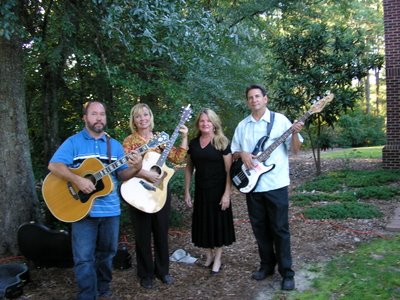
Pictured, from left are Tim Wilson, Sarah Harned, Cynthia Williams Leake and Joe Fitzgerald.
Movin' Through: Having fun in three-part harmony
Moore County Independent, Oct. 19, 2006
SPECIAL TO THE INDEPENDENT
Joe Fitzgerald, Sarah Harned, Cynthia Leach and Tim Wilson have at least one thing in common: They love their music.
They are the members of a local pop band called Movin' Through, and they love to work their three-part harmony on rock 'n' roll (soft and hard), country, blues, doo-wop, folk, Motown -- about any genre you can think of.
The band plays at clubs, private parties, weddings and anniversaries.
Movin' Through especially caught the ear of those attending the Pathway to Awareness events on Oct. 1 in Pinehurst, a mini-festival highlighting a visit by movie star Patty Duke. They performed all afternoon outside the Village Hall. Their friend and fellow musician, Tom "Lefty" Compa, spelled them occasionally with his solo act.
Harned, Leach and Wilson put their band together four years ago. They had sung together in their church choir, which was how they came to know each other, Wilson said. Fitzgerald, a U.S. Army veteran living in Cameron, joined Movin' Through last year. He plays bass for the band. Harned, Leach and Wilson do vocals in three-part harmony. Wilson has played acoustic guitar from the time the band formed, and Harned has started playing guitar as well. "We've got some percussion, too," Wilson said.
Movin' Through has recently enjoyed a bit of serendipity. In their Oct. 1 gig at the Village Hall, a representative from the Belk clothing store chain talked with them about performing at the opening of their new store at the Pinecrest Plaza. The band has been booked to play there Saturday, Nov. 4, from about 11:30 a.m. to 1 p.m., Wilson said.
Vocal harmonies are their main thing.
"We love vocal harmonies, three-part harmonies, which allows us to do all sorts of things, doo-wop, country and other things," Wilson said.
"We tend to do a lot of music that people haven't heard in a long time," Wilson said. "But we also want to do some original stuff. We're hoping to do some recording in the near future."
Fitzgerald moved to Cameron from Fayetteville 12 years ago. He did not play much music during his military service. "I thought they were kidding when me when they asked me to play bass with them one day," Fitzgerald said of his bandmates.
Harned, Leach and Fitzgerald are all Moore County natives.
Harned was born in Carthage, graduated from Union Pines High School and studied music at the University of North Carolina at Greensboro. "I've done theatre, too," she said.
Harned got into music in high school. She is currently employed as a teaching assistant at West End Elementary School.
One of the things she likes most is the reaction of the crowd. "You can make them cry, you can make them laugh," she said.
Wilson grew up in Sanford before moving back to his Moore County birthplace. He now lives close to Aberdeen.
Leach (nee Williams) has taught special education in the Moore County Schools. She currently serves as a substitute. Music has been a major part of her life, and still is. Leach has beein singing with the Moore County Choral Society for the past 25 years.
Leach studied dramatics and was a member of the chorus at Pinecrest High School and received a degree in special education at Pembroke State University (now the University of North Carolina at Pembroke).
Wilson described the way the band has grown together.
"After four years we start to feel each other," he said. "Vocal harmonies come easier after you've come to know each other for awhile."
"We do a lot of our music by ear," he added. "We haven't even looked at a piece of music.
"We've broadened our repertoires quite a bit. We've broadened things out, which has been really good for us."
There is nothing like playing music in front of a room full of people, Wilson said. "We like to take a noisy room, and then suddenly it becomes quiet," he said.
A band can have all the things they like: Vocal skills, instruments, performers with different individual styles.
There's one ingredient that Movin' Through can't do without, Wilson said: Fun.
"One of the biggest things is, we have a good time," Wilson says.
"If we have a good time, they (the listeners) have a good time."
***
Contact correspondent Bill Lindau at blindau52@yahoo.com or (910) 461-7804.
Patty Duke's visit
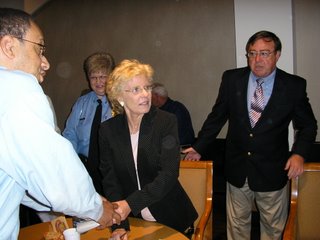



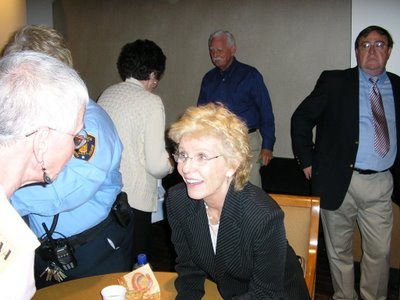
'Miracle Worker' star visits Sandhills
Patty Duke delivers passionate speech on bout with bipolar disorder
Moore County Independent, Oct. 5, 2006
SPECIAL TO THE INDEPENDENT
Patty Duke has played roles ranging from a famous blind and deaf-mute woman to identical twin cousins to a doped-out diva.
Lately she has attracted lots of fans with a real-life role: A champion for the mentally ill.
Duke, with husband Mike Pearce in tow, spoke before a packed audience at Sandhills Community College on Saturday evening.
Duke shared some of her ugly experiences with bipolar disorder. Also known as manic depression, this malady had plagued her since she was 19 years old, she said.
After the speech, Duke signed copies of the books she had written about mental illness, at a reception in Kennedy Hall.
During the question-and-answer session, some people shared their experiences with bipolar disorder with their famous guest speaker. A few even said that Duke's second book, "A Brilliant Madness," helped them cope with their own cases of this oft-publicized psychiatric malady.
Duke was the guest speaker in the second program in the new Ruth Pauley Lecture Series. Her program was titled "A Brilliant Madness: Living with Manic-Depressive Illness." The series is in its 20th year. This series, which featured biographer Mary Skutt as its first speaker of the new season in September, has been hailed as the longest-running series of its kind in the American community college system.
Duke spent the weekend in the Sandhills. On Sunday she was the featured guest at Pinehurst, in the Path to Awareness program that was held at the Pinehurst Village Hall. She signed copies of both "A Brilliant Madness" and her 1987autobiography, "Call Me Anna", at the assembly hall. This event also featured a walk, a "Candles in the Sky" observance which consisted of helium balloons released in memory or in honor of loved ones, door prizes, the giveway of a painting by Charlotte artist Stefan Duncan; and a performance by local pop band Movin' Through. These events were co-sponsored by Sandhills Community College Foundation, the National Alliance for Mental Illness and FirstHealth of the Carolinas.
Duke spoke for about an hour, then fielded questions from the audience. There was standing room only reported at the time she spoke in Owens Auditorium.
Some members of the audience arrived at least an hour before Duke was scheduled to speak, in anticipation of a vast crowd. The event was free, open to the public, and heavily publicized.
At Duke's speech on Saturday, one woman said she had suffered from bipolar disorder for 14 years and went into intensive therapy following a suicide attempt. She read "A Brilliant Madness", and claimed the book brought her and her mother together.
One of the first people to ask Duke any questions admitted to having bipolar disorder and asked Duke if she had any trouble sleeping.
"I'm touched that a girl like you had the courage to come here and speak up," Duke said.
Duke said she has been taking lithium for her therapy, beginning her current treatment 25 years ago. She advised people with psychiatric illness not to be ashamed of it and to continue taking their medication.
"I will take my medication till the day I die," she said, "And knowing me, I'll take it the day after."
Duke turns 60 in December. She has acted in movies and on TV for more than 40 years. She won an Oscar for her portrayal of the famous Helen Keller in "The Miracle Worker" as a child. In her teens she starred in a sitcom called "The Patty Duke Show" in which she played a dual role as identical twin cousins. In 1969 she played a famous singer with a drug problem in "Valley of the Dolls". That role is said to have been modeled after Judy Garland. Her other cinematic highlights included a remake of "The Miracle Worker", in which she took Anne Bancroft's former role in the previous version.
Duke told how in Saturday's speech how she began experiencing the symptoms of a psychiatric disorder when she was 19.
"The Patty Duke Show had just wrapped," she said. "I had been married for about a year when all of a sudden this pall came over me."
In time it afflicted her to the point at which "I didn't get out of bed except to go to the bathroom," Duke said, "And I had to debate that some."
She said she was hospitalized after a suicide attempt.
Throughout her speech, Duke managed to put a comic spin on some of the incidents.
"I was talking so fast you couldn't understand me," she said, discussing her other symptoms. "Sally Field did it in an episode of 'ER" and I kept wondering how come I didn't get the job."
"My motor was running and then it would stop," she added.
She said she was released from the hospital before she was completely cured, being misdiagnosed for depression solely. She continued to be in need of help, she said, but, she did not go to another psychiatrist for a long time. "We were worried about my image," Duke said. "I was little Patty Duke and I couldn't possibly have a mental illness."
She said her husband at the time was cheating on her. "But when I found out, I was in another manic episode," Duke added. :"I had also started drinking. That was my second career."
She said in the late 1960s, when she became more established in her acting career, "I had another manic episode. I bought a lot of cars that I couldn't afford."
Duke also said she was bar-hopping, "having indiscriminate sexual encounters with people I didn't know."
During this time, however, she said she had "a little conscience" that told her she could not go on like that, and she knew she had to changer her ways.
She found a boyfriend who left her when she became pregnant. Then she married "Addams Family" star John Astin, who had children from an earlier marriage. Duke's marriage with Astin fell apart largely to her disorder.
"I was not marriage or mom material," Duke said. "I was manic. The kids were subject to my rage and physical abuse....One minute I'd tell them that they were king of the world. The next minute I'd be smacking them and berating them and telling them how much I berated them."
She said she once told Astin a divorce would be the best thing for both of them. "I told john he'd have to give me a divorce because I was afraid I'd kill him in his sleep," Duke said.
During the divorce proceedings, Duke saw a psychiatrist again. The seventh time she saw him, "the psychiatrist said I was manic-depressive," Duke said. "And I thought, 'Oh, thank God, it has a name.'"
That was when she began lithium treatments, Duke said.
"The motor stopped running," she said, "and I started taking my medication and I have for the past 20-some years."
Duke talked about landing a movie role as a 39-year-old woman who enlists in the Army to obtain benefits. She was sent to a military base in Georgia, to train for the part under a drill instructor.
Commenting on the sergeant assigned to her, Duke said, "You'd think that all the blue eyes in the world were in his head. He was very nice -- and he beat the (expletive deleted) out of me."
The sergeant was Mike Pearce. She ended up marrying him. During the past summer they celebrated their 20th wedding anniversary, she said. They now live in northern Idaho, with their 12-year-old son, Kevin, and five dogs.
Duke said she remains committed to fight for the rights of patients with bipolar disorder and other forms of mental illness. This includes health insurance.
"I've been working hard with NAMI National to achieve insurance parity," Duke said.
"We (NAMI) are trying to get Congress to give mental patients the same coverage they do for physical disorders," Duke added. Also, "to cut $6 million in child research and treatment is a sin."
Meeting Patty Duke
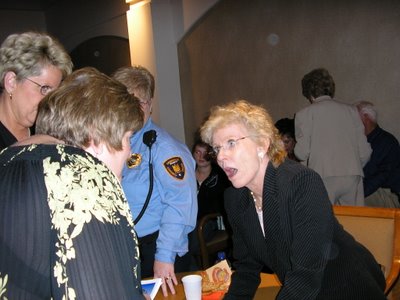 Patty Duke: A real white knight
Patty Duke: A real white knightPublished in The Moore County Independent, Oct. 12, 2006
SPECIAL TO THE INDEPENDENT
I remember little of "The Patty Duke Show" except for the theme, "...You can lose your mind/when cousins are two of a kind." and loved this woman's heart-rending performance as the drugged-out Neely O'Hara in "Valley of the Dolls." Now I have fallen in love with Patty Duke all over again, after her speech Sept. 30 at Sandhills Community College.
Duke didn't talk so much about her career as she did her own ordeal with bipolar disorder. It was a story about her the moviegoing public didn't know at the time. And I got the feeling she was not aiming to plug her new book as to speak up on the plight of people with bipolar disorder and other psychiatric maladies.
And there are a lot of those people.
I honestly believe her speech in the Ruth Pauley Lecture Series was the best news assignment I've ever had.
It wasn't just meeting a movie star, it was the unexpected reaction to her speech that had me so gobsmacked. At her question and answer slot at the end of her speech, a number of people in the audience spoke up and said they suffered from bipolar disorder themselves. One had a relative who needed treatment for it; another said she was being treated for schizophrenia.
I think, about 30 to 40 years ago, a lot of these people would've kept it a secret and taken it to their graves. Now, undergoing mental therapy does not have the stigma it once did, not among the more enlightened of us; in fact, people who decide to seek such help often receive a pat on the back from their friends and relative. And we know there are plenty of people who don't seek treatment that certainly need it.
People with psychiatric disorders deserve all the support and encouragement they can get as they deal with their problems. And Patty Duke showed how much she was behind them with her speech.
She showed you don't need a horse and a suit of armor to be a white knight. With her work with the National Alliance for the Mentally Ill (NAMI), her lobbying of Congress and her own candid autobiography, "Call Me Anna" along with "A Brilliant Madness", she is indeed a white knight.
Come to think of it, there are a lot of people who wouldn't have talked about their therapy until the night they came to Patty Duke's speech.
"I think a lot of them felt encouraged by that first person," a fellow audience member told me. "And that kind of started the ball rolling."
Just before the first of those patients admitted her disorder, I asked a question of my own during that question-and-answer period. But it was about her sons McKenzie and Sean following in their mother's thespian footsteps. She said something like, "Oh, boy," and then talked about how she was proud of them and how she loved playing with her grandchildren.
At first I was going to ask how much of her own situation she put into the character of Neely O'Hara. But then I figured there was too great a chance of that question sounding somewhat less than tactful so I stuck to a show-business question.
During the questions that followed, I came up with something I wanted to say to her at the reception that followed in the college's Kennedy Building. (I knew she did not have time for a full-blown newspaper interview, and figured I'd be lucky if I got to talk to her at all.
Everybody went there and she signed copies of both her books. I did not buy one of her books (I did the next day, though), but she signed my program for me. I told her I was the one who asked the question about her sons.
"Oh, that was you," Duke said with a sly grin.
"It was," I said. "I also want to tell you that it was great that those people had the courage to speak up about their illnesses. You know, I underwent therapy myself, when I was 20 and then a few years ago. I wanted to carry it to my grave."
"Thank you," she said. "It's not something you should carry to their graves."
Then she asked me my name and signed my program.
It wasn't much of a conversation, and she must have talked to hundreds of people that night.
But what happened the next day was equally surprising.
I attended her Oct. 1 appearance at the Pinehurst Village Hall. I wasn't after another autograph, but I sat in the assembly room for a few minutes.
Just as Patty was coming to the podium, she looked at me, waved and said "How you doing?"
I'll never forget the smile she flashed at me as long as I lived. I wish I'd gotten a photo of that instant.
And I'll never forget the great, relieved feeling after my little confession to her the day before.
In the past, the only people outside my therapy teams were my very small family and five highly trusted friends (maybe not even that many). Now I don't feel like hiding it. I won't go into any more detail about my therapy, but I don't care who knows about it.
As long as they cut me some slack, such as hiring me or becoming my friend.
When I was 20 years old, I would never have dreamed of admitting I underwent therapy to a beautiful movie star.
Some people who read this may think I was out of my mind.
That's fine. You're all entitled to your opinions.
But I'll never forget what happened when I saw Patty Duke.
And I wouldn't trade the wonderful feeling that came over me for anything on God's Green Earth.
Voit Gilmore
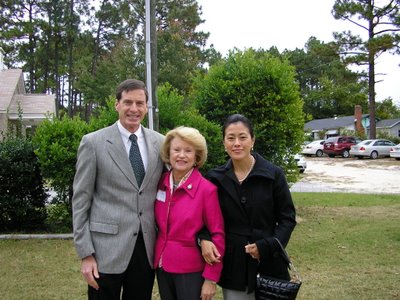
Voit Gilmore: The good that lives after him
Submitted to The Moore County Independent, Tuesday, Oct. 17, 2006With photo of Voit Gilmore's son Peter, Voit's widow Jody and Peter's wife, Carolina.
SPECIAL TO THE INDEPENDENT
Too bad Shakespeare never met Voit Gilmore.
When Marc Antony in Julius Caesar said, "The evil that men do lives after them. The good is oft interred with their bones," he didn't say anything about exceptions to that rule.
The late philanthropist Voit Gilmore was such an exception. The Sandhills/Moore Coalition for Human Care Inc. showed how much the good you do can live after you when they named their new building after him -- on his birthday.
Gilmore, who came to Southern Pines just after World War II and served as a mayor, town councilman and operated a travel agency here, donated about nine acres of land around Indiana Avenue before he passed away last year. The future site of the Coalition's client services building, along with that of a Head Start facility, are on some of that land.
Gilmore (Oct. 13, 1918-Oct. 15, 2005) may very well have been the wealthiest person who ever lived in Southern Pines. But he didn't spend his money on big houses and expensive cars -- he used his money to do everybody some good. He didn't just make things happen by flashing his money around; he came out and actually helped, serving as a councilman and mayor in Southern Pines and a senator in the North Carolina legislature. He was a friend of my mother and father and two of his children were friends of mine and I am delighted to have known them for close to 40 years.
I've never been rich and I'm a bit of a socialist. At the same time, I've never judged people solely by the amount of their possessions. Meeting Voit Gilmore at an early age cured me of that kind of socioeconomic prejudice. And the local news media have shown us that the late political leader and businessman had a heart to match his bank account.
Naming a new building after the former state senator, travel agent, writer and mayor of Southern Pines was a great way to say thanks to this wonderful man.
Gilmore was one of the first people in Southern Pines that my parents got to know when we moved from Winston-Salem in August 1966. Winston-Salem, coincidentally, was Gilmore's birthplace.
One of his three daughters, Susie, was in my class at East Southern Pines High School, and one of his two sons, Peter, was in my Boy Scout troop, Troop 223. They went to other schools before they graduated, but I still remember them, and I met Peter when he came to the building dedication earlier this month. He is now vice-president of the Dole Fruit Company (I wonder how Liddy and Bob like that -- Voit was one of the biggest Democrats in the state!). He came up with his wife, Carolina, and he had the look of a big wheel: Tall, well-dressed, not a hair out of place and really trim, hardly the look of somebody about 52 years old.
Susie G. Stone lives in California. She worked in public broadcasting for many years and now she works in social services, Peter said.
The Gilmores owned a lot of land in the Sandhills and also the western part of the state. In 2002 he and his former wife, Kathryn McNeill, donated 452 acres of land and buildings at Purchase Knob to the Great Smoky Mountains National Forest. An eye-popping figure, but I'm not surprised.
The Gilmores owned much of the land around Pinecrest High school and the Pinecrest Plaza, on the outskirts of Southern Pines. In fact, some of my friends and I used to go swimming in a lake on his property behind the high school. Peter gave me a sly grin when I mention that lake and how we used to sneak out there when it got warm enough. I can't remember the Gilmores ever arresting anybody for trespassing, as long as you didn't leave a bunch of trash out there.
Felton Capel was one of Voit Gilmore's oldest friends. Their friendship went back to the 1950s, when Capel served on the Southern Pines Town Council. Capel has gone down in Sandhills history as the first African-American to serve on that particular governing body. He remembers Gilmore as a champion of civil rights and integration.
Voit Gilmore made his mark on our fair state as early as his college years. At the University of North Carolina, he was chairman of the Carolina Political Union (he graduated from UNC in 1939, with a degree in journalism). In that office, he performed the amazing act of getting President Franklin D. Roosevelt to come down and give a speech at the school.
After serving in the Navy in World War II, Gilmore secured a position at Pan Am Airlines, which flew him to places such as South America and Africa. This gave him a case of Wanderlust which he indulged all his life.
Early in the 1960s, his career in public service and travel really took off (pardon the pun). In 1961, President John F. Kennedy appointed him director of the United States Travel Service. His political career would include a few terms as mayor of Southern Pines and terms in the state senate. He also made an unsuccessful bid for the Democratic nomination for governor of North Carolina.
He operated the Four Seasons Travel Agency and in the last years of his life lived in Pinehurst with his wife, Jody. He wrote a local newspaper column as well, talking about his various travels. In 2003, N.C. Gov. Mike Easley awarded him the prestigious Order of the Long Leaf Pine.
I can't imagine anybody not liking Voit Gilmore, not even rock-ribbed Republicans. I never new anybody personally who did so much good for so many people. We're all going to remember him and we're all so missing him.













